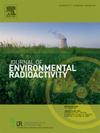Engineering barriers in deep geological disposal: Implications for radioactive nuclide migration and long-term safety
IF 1.9
3区 环境科学与生态学
Q3 ENVIRONMENTAL SCIENCES
引用次数: 0
Abstract
The rapid growth of nuclear energy technology, along with the expansion of global nuclear power projects, has led to a significant increase in high-level radioactive wastes (HLWs), particularly spent fuel from nuclear power plants. The disposal of HLWs remains a major challenge due to its high radioactivity, long half-lives, and complex management requirements. Ensuring the long-term safety of HLW disposal is critical for the sustainable development of nuclear energy. Currently, deep geological disposal is considered the most effective and secure method for isolating HLW. This method relies on a multi-barrier system that combines natural geological barriers with artificial engineering barriers to achieve the long-term isolation of radioactive wastes. Engineering barriers, including waste containers, buffering materials, and backfill materials, are essential for preventing radioactive leakage and maintaining isolation in the face of geological and environmental changes. Recent studies have focused on the design and optimization of these barriers, particularly their impact on the migration of key radioactive nuclides. Insights from international practices and technological advancements have highlighted the importance of materials like bentonite, disposal containers, and other engineering barriers in optimizing multi-barrier systems for HLW disposal. Bentonite, a widely used buffering material, is known for its excellent adsorption properties and low permeability. Recent modifications to bentonite have enhanced its ability to adsorb radioactive nuclides such as cesium (Cs) and plutonium (Pu), significantly improving the safety and long-term stability of disposal facilities. Additionally, the migration mechanisms of radioactive nuclides have been examined, with particular attention to the influence of hydrochemical conditions—such as hydration, ion concentration, and pH—on bentonite's adsorption capabilities. This study sheds light on the migration pathways and rates of these nuclides in HLW disposal systems. Another key area of focus is the materials used for disposal containers, particularly cement-based and metal materials, which play a critical role in mitigating corrosion risks during long-term storage. While experimental data show promising corrosion resistance under specific conditions, continued researches are necessary to evaluate the long-term durability of these materials. These findings provide valuable theoretical insights for the engineering design of HLW geological disposal, offering references for the site selection, design, and material optimization of disposal facilities, particularly in China. As experimental data and theoretical models continue to evolve, future safety assessments and long-term behavior predictions will become more accurate. By promoting international collaboration and interdisciplinary research, these efforts contribute to the development of a scientific foundation for the safe and sustainable disposal of HLWs, ensuring environmental safety and the long-term effectiveness of waste management strategies.
深层地质处置中的工程屏障:对放射性核素迁移和长期安全的影响
核能技术的迅速发展,以及全球核电项目的扩大,导致高放射性废物(HLWs)的显著增加,特别是来自核电厂的乏燃料。由于高放射性物质的高放射性、长半衰期和复杂的管理要求,高放射性物质的处置仍然是一个重大挑战。确保高放射性废物处置的长期安全是核能可持续发展的关键。目前,深部地质处置被认为是隔离高浓缩铀最有效、最安全的方法。该方法依靠天然地质屏障与人工工程屏障相结合的多屏障系统,实现放射性废物的长期隔离。工程屏障,包括废物容器、缓冲材料和回填材料,对于防止放射性泄漏和在面对地质和环境变化时保持隔离至关重要。最近的研究集中在这些屏障的设计和优化上,特别是它们对关键放射性核素迁移的影响。来自国际实践和技术进步的见解强调了膨润土、处置容器和其他工程屏障等材料在优化高放射性废物处置多屏障系统中的重要性。膨润土是一种广泛使用的缓冲材料,具有优异的吸附性能和低渗透性。最近对膨润土的改性增强了其吸附放射性核素(如铯和钚)的能力,显著提高了处置设施的安全性和长期稳定性。此外,研究人员还研究了放射性核素的迁移机制,特别关注了水化学条件(如水合作用、离子浓度和ph值)对膨润土吸附能力的影响。这项研究揭示了这些核素在高放射性废物处置系统中的迁移途径和速率。另一个重点领域是用于处置容器的材料,特别是水泥基材料和金属材料,它们在减少长期储存期间的腐蚀风险方面发挥着关键作用。虽然实验数据显示在特定条件下具有良好的耐腐蚀性,但仍有必要继续研究以评估这些材料的长期耐久性。这些研究结果为高浓缩铀地质处置工程设计提供了有价值的理论见解,为高浓缩铀地质处置设施的选址、设计和材料优化提供了参考。随着实验数据和理论模型的不断发展,未来的安全评估和长期行为预测将变得更加准确。通过促进国际合作和跨学科研究,这些努力有助于为安全和可持续处置高放射性废物奠定科学基础,确保环境安全和废物管理战略的长期有效性。
本文章由计算机程序翻译,如有差异,请以英文原文为准。
求助全文
约1分钟内获得全文
求助全文
来源期刊

Journal of environmental radioactivity
环境科学-环境科学
CiteScore
4.70
自引率
13.00%
发文量
209
审稿时长
73 days
期刊介绍:
The Journal of Environmental Radioactivity provides a coherent international forum for publication of original research or review papers on any aspect of the occurrence of radioactivity in natural systems.
Relevant subject areas range from applications of environmental radionuclides as mechanistic or timescale tracers of natural processes to assessments of the radioecological or radiological effects of ambient radioactivity. Papers deal with naturally occurring nuclides or with those created and released by man through nuclear weapons manufacture and testing, energy production, fuel-cycle technology, etc. Reports on radioactivity in the oceans, sediments, rivers, lakes, groundwaters, soils, atmosphere and all divisions of the biosphere are welcomed, but these should not simply be of a monitoring nature unless the data are particularly innovative.
 求助内容:
求助内容: 应助结果提醒方式:
应助结果提醒方式:


